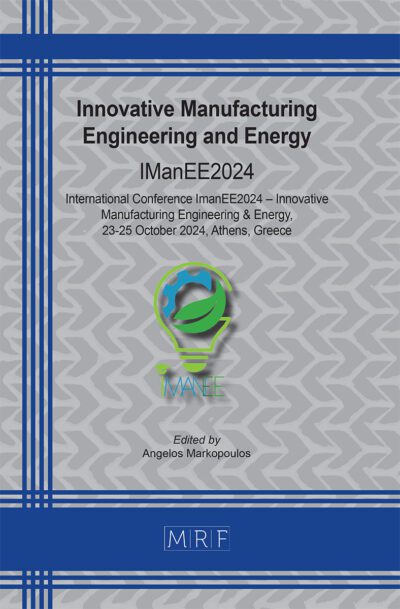Hemp/PLA impregnated yarn produced by pultrusion
Luca Boccarusso, Massimo Durante, Martina Panico, Maria Rosaria Ricciardi, Marco Russo, Antonio Langella
Abstract. Natural fiber-reinforced polymer (NFRP) composites are gaining attention for their sustainability and potential to replace petroleum-based materials. Polylactic acid (PLA), a biodegradable thermoplastic derived from renewable resources, is a promising matrix material but suffers from brittleness and limited mechanical properties. Hemp fibers, with their good mechanical characteristics and environmental benefits, offer an effective reinforcement solution. A typical issue when using hemp reinforcement in form of fabric is the difficulty of fully impregnating the yarn core with the matrix, especially in the case of a thermoplastic matrix. Moreover, the use of fabrics inevitably leads to the formation of crimp and, in the case of very flexible materials such as vegetable fibers, also waviness. To overcome these challenges, this work proposes a pultrusion-based process for producing hemp/PLA yarns, which are subsequently used for the production of 0/90/0 and 90/090 composite laminates through hot press forming process. The feasibility of the processes was investigated, and the mechanical properties of the produced composites were evaluated through three-point bending tests. The results demonstrated interesting mechanical performances and suitability for technical applications, while also addressing challenges in fiber impregnation.
Keywords
Vegetable, Bio-Composites, Manufacturing, Moulding, Non-Conventional Process
Published online 5/7/2025, 7 pages
Copyright © 2025 by the author(s)
Published under license by Materials Research Forum LLC., Millersville PA, USA
Citation: Luca Boccarusso, Massimo Durante, Martina Panico, Maria Rosaria Ricciardi, Marco Russo, Antonio Langella, Hemp/PLA impregnated yarn produced by pultrusion, Materials Research Proceedings, Vol. 54, pp 2168-2174, 2025
DOI: https://doi.org/10.21741/9781644903599-233
The article was published as article 233 of the book Material Forming
![]() Content from this work may be used under the terms of the Creative Commons Attribution 3.0 license. Any further distribution of this work must maintain attribution to the author(s) and the title of the work, journal citation and DOI.
Content from this work may be used under the terms of the Creative Commons Attribution 3.0 license. Any further distribution of this work must maintain attribution to the author(s) and the title of the work, journal citation and DOI.
References
[1] D. De Fazio, L. Boccarusso, M. Durante, Tribological Behaviour of Hemp, Glass and Carbon Fibre Composites, Biotribology 21 (2020). https://doi.org/10.1016/j.biotri.2019.100113
[2] F. Quadrini, G. Patrizii, A. Proietti, L. Iorio, D. Bellisario, L. Santo, Compression Molding of Low-Density Polyethylene Matrix/Glass-Fiber-Reinforced Thick Laminates, Polym. (Basel) 16 (2024). https://doi.org/10.3390/polym16192722
[3] L. Boccarusso, D. De Fazio, M. Durante, Production of PP composites reinforced with flax and hemp woven mesh fabrics via compression molding, Inventions 7 (2022). https://doi.org/10.3390/inventions7010005
[4] X. Li, Y. Lin, M. Liu, L. Meng, C. Li, A review of research and application of polylactic acid composites, J. Appl. Polym. Sci. 140 (2023). https://doi.org/10.1002/app.53477
[5] M. Ejaz, M.M. Azad, A.U.R. Shah, S.K. Afaq, J. il Song, Mechanical and Biodegradable Properties of Jute/Flax Reinforced PLA Composites, Fibers Polym. 21 (2020) 2635–2641. https://doi.org/10.1007/s12221-020-1370-y
[6] L. Boccarusso, F. Pinto, K. Myronidis, D. De Fazio, M. Durante, Thin Hybrid Hemp/Carbon Fiber Composites: Manufacturing, Flexural, and Impact Behavior, J. Mater. Eng. Perform. 32 (2023) 3914–3922. https://doi.org/10.1007/s11665-023-07992-5
[7] L. Boccarusso, F. Pinto, S. Cuomo, D. De Fazio, K. Myronidis, M. Durante, M. Meo, Design, Manufacturing, and Characterization of Hybrid Carbon/Hemp Sandwich Panels, J. Mater. Eng. Perform. 31 (2022) 769–785. https://doi.org/10.1007/s11665-021-06186-1
[8] R. Dragonetti, M. Napolitano, L. Boccarusso, M. Durante, A study on the sound transmission loss of a new lightweight hemp/bio-epoxy sandwich structure, Appl. Acoust. 167 (2020). https://doi.org/10.1016/j.apacoust.2020.107379
[9] W. Zhai, P. Wang, X. Legrand, D. Soulat, M. Ferreira, Effects of micro-braiding and co-wrapping techniques on characteristics of flax/polypropylene-based hybrid yarn: A comparative study, Polym. (Basel) 12 (2020) 1–14. https://doi.org/10.3390/polym12112559
[10] B. Baghaei, M. Skrifvars, L. Berglin, Manufacture and characterisation of thermoplastic composites made from PLA/hemp co-wrapped hybrid yarn prepregs, Compos. Part A Appl. Sci. Manuf. 50 (2013) 93–101. https://doi.org/10.1016/j.compositesa.2013.03.012












